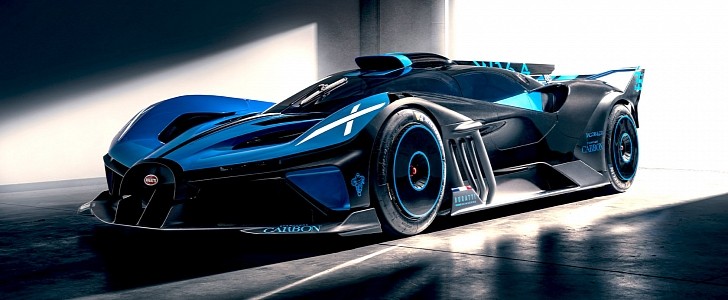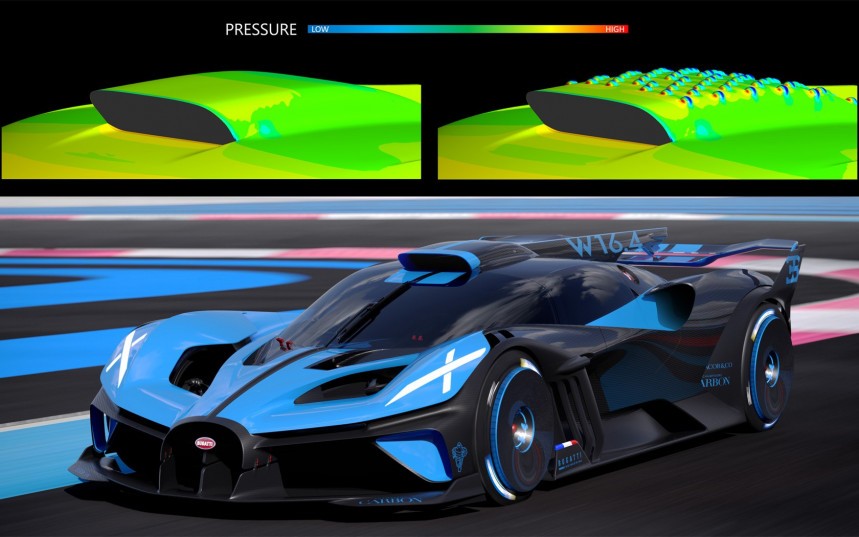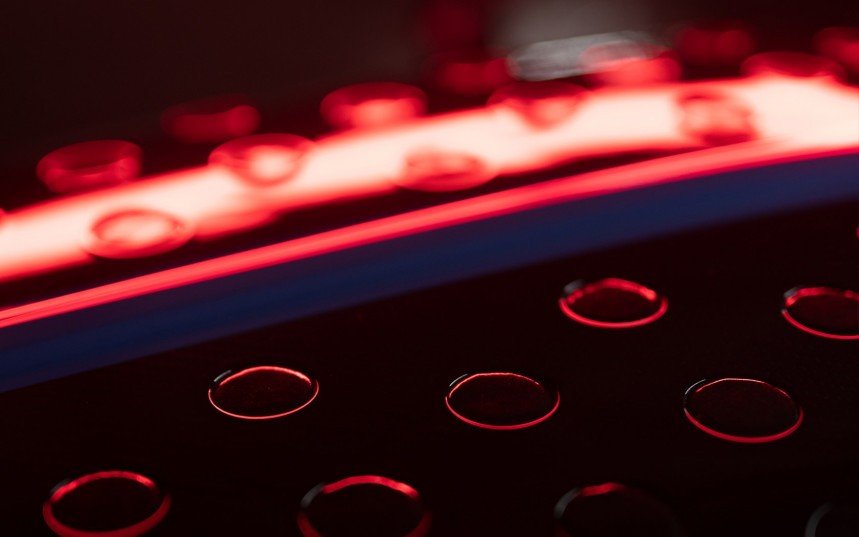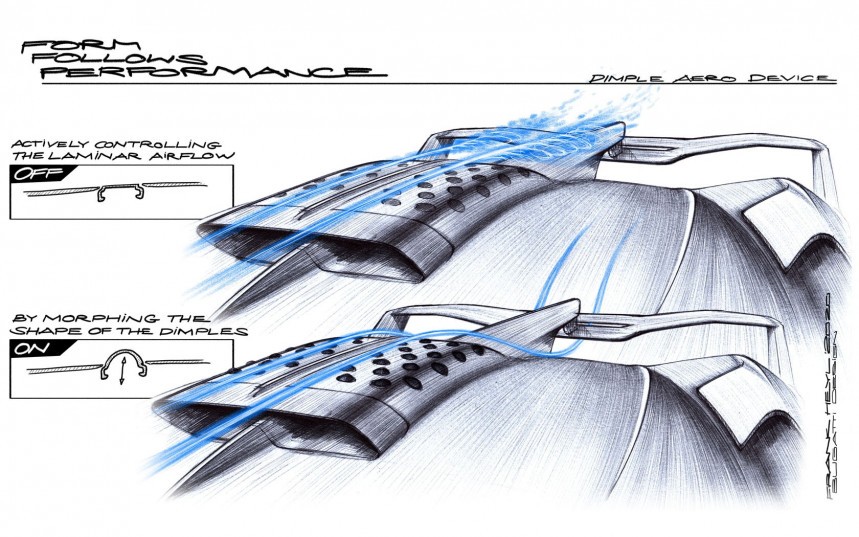For almost a century, automotive engineers have been continuously developing and enhancing aerodynamics to reduce drag and build faster cars. They started by redesigning the shape of the bodies, then added vents, nozzles, and spoilers. In modern times, active aerodynamics is the go-to technology for faster race and road cars, and Bugatti takes it one step further by introducing the first active roof scoop on its revolutionary Bolide concept.
Introduced to the world a few weeks ago, the Bolide represents a new era for Bugatti, which took a break from creating the world’s most extravagant hypercars and focused on developing an insane race machine.
Powered by the legendary 8.0-liter W16 engine that is optimized to produce a mind-blowing 1,850 PS (1,361 kW/1,825 hp), the 1,240-kg (2,734-lbs) Bolide has an extraordinary power-to-weight ratio of 0.67 kg/PS (0.67 hp per lbs).
This is achieved by employing the latest advancements in aerodynamics, which include a new cutting-edge invention: the morphing dimple roof scoop.
Inspired by the design of a golf ball, the dimples generate turbulence so that air sticks better to the surface, reducing the vortex flow in the slipstream and thus minimizing drag.
When the Bolide cruises at low speeds, the surface of the scoop remains smooth; however, when its monstrous power is unleashed, a series of dimples bulge out of its surface.
No fewer than sixty individual dimples variably extend up to 10 mm (0.39 in) to improve aerodynamics. From speeds that exceed 80 kph (50 mph), air is the dominant resistance factor, and from 120 kph (75 mph), the dimples considerably enhance the car’s aerodynamics by decreasing this resistance.
As with the golf ball, this pattern creates a turbulent boundary layer that makes the air flowing around it stick to the surface for longer.
The dimples extend and retract within tenths of a second to effectively respond to changes in speed. As a result, the aerodynamic drag of the scoop is reduced by 10 %, while lift also decreases by 17%.
At speeds of around 320 kph (199 mph), the downforce pushing on the rear wing is 1,800 kg (3,968 lbs), while the weight on the front wing exceeds 800 kg (1,764 lbs).
The active roof scoop optimizes the airflow that reaches the rear wing helping the Bolide achieve these excellent downforce stats. It also reduces the vehicle’s fuel or energy consumption, which is a critical development not just for Bugatti but for the whole automotive industry.
The mastermind behind this innovation is promising young German engineer Nils Ballerstein. Since the beginning of 2020, he has been preparing a doctoral thesis project for the development of a unique morphing outer skin for Bugatti’s New Technologies department. His brilliant idea was incorporated into the innovative hyper sports car.
It all started a year earlier when Ballerstein was working on his master’s degree. His research focused on new 3D-printed titanium brake calipers which cool water as it flows through them.
To improve heat transfer and depletion, he used a dimple pattern incorporated into the channels to produce turbulence, inspired by the design of a golf ball. Upon doing so, he noticed that the temperature inside the caliper dropped significantly.
“I was positively surprised when I saw the results with the surface patterns. I then wondered whether the same effect couldn’t be achieved with airflow,” says Ballerstein.
The Bolide is unquestionably one of the most epic cars ever created and represents Bugatti’s apogee of automobile construction centered around a combustion engine that started more than a century ago.
Although it’s momentarily just a concept, we can only hope that it will grace the racetracks at some point to showcase its marvelous innovations in a fierce race such as the 24 Hours of Le Mans.
Powered by the legendary 8.0-liter W16 engine that is optimized to produce a mind-blowing 1,850 PS (1,361 kW/1,825 hp), the 1,240-kg (2,734-lbs) Bolide has an extraordinary power-to-weight ratio of 0.67 kg/PS (0.67 hp per lbs).
This is achieved by employing the latest advancements in aerodynamics, which include a new cutting-edge invention: the morphing dimple roof scoop.
When the Bolide cruises at low speeds, the surface of the scoop remains smooth; however, when its monstrous power is unleashed, a series of dimples bulge out of its surface.
No fewer than sixty individual dimples variably extend up to 10 mm (0.39 in) to improve aerodynamics. From speeds that exceed 80 kph (50 mph), air is the dominant resistance factor, and from 120 kph (75 mph), the dimples considerably enhance the car’s aerodynamics by decreasing this resistance.
The dimples extend and retract within tenths of a second to effectively respond to changes in speed. As a result, the aerodynamic drag of the scoop is reduced by 10 %, while lift also decreases by 17%.
At speeds of around 320 kph (199 mph), the downforce pushing on the rear wing is 1,800 kg (3,968 lbs), while the weight on the front wing exceeds 800 kg (1,764 lbs).
The active roof scoop optimizes the airflow that reaches the rear wing helping the Bolide achieve these excellent downforce stats. It also reduces the vehicle’s fuel or energy consumption, which is a critical development not just for Bugatti but for the whole automotive industry.
The mastermind behind this innovation is promising young German engineer Nils Ballerstein. Since the beginning of 2020, he has been preparing a doctoral thesis project for the development of a unique morphing outer skin for Bugatti’s New Technologies department. His brilliant idea was incorporated into the innovative hyper sports car.
To improve heat transfer and depletion, he used a dimple pattern incorporated into the channels to produce turbulence, inspired by the design of a golf ball. Upon doing so, he noticed that the temperature inside the caliper dropped significantly.
“I was positively surprised when I saw the results with the surface patterns. I then wondered whether the same effect couldn’t be achieved with airflow,” says Ballerstein.
The Bolide is unquestionably one of the most epic cars ever created and represents Bugatti’s apogee of automobile construction centered around a combustion engine that started more than a century ago.
Although it’s momentarily just a concept, we can only hope that it will grace the racetracks at some point to showcase its marvelous innovations in a fierce race such as the 24 Hours of Le Mans.
















